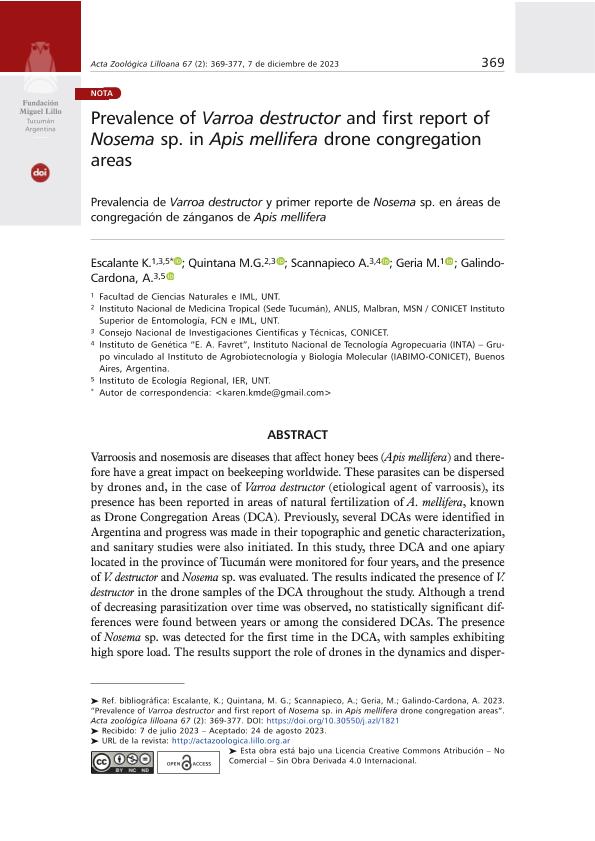Artículo
Varroosis and nosemosis are diseases that affect honey bees (Apis mellifera) and there-fore have a great impact on beekeeping worldwide. These parasites can be dispersed by drones and, in the case of Varroa destructor (etiological agent of varroosis), its presence has been reported in areas of natural fertilization of A. mellifera, known as Drone Congregation Areas (DCA). Previously, several DCAs were identified in Argentina and progress was made in their topographic and genetic characterization, and sanitary studies were also initiated. In this study, three DCA and one apiary located in the province of Tucumán were monitored for four years, and the presence of V. destructor and Nosema sp. was evaluated. The results indicated the presence of V. destructor in the drone samples of the DCA throughout the study. Although a trend of decreasing parasitization over time was observed, no statistically significant dif-ferences were found between years or among the considered DCAs. The presence of Nosema sp. was detected for the first time in the DCA, with samples exhibiting high spore load. The results support the role of drones in the dynamics and dispersal al of diseases and allow us to conclude that the analysis of DCAs represents a key tool for monitoring the health of bee populations, complementary to the analyses carried out in apiaries. La varroosis y la nosemosis son enfermedades que afectan a las abejas melíferas (Apis mellifera) y por lo tanto tienen un gran impacto en la apicultura a nivel mundial. Estos parásitos pueden ser dispersados por los zánganos y, en el caso de Varroa destructor se ha reportado su presencia en áreas de fecundación natural de A. mellifera, conocidas como Áreas de Congregación de Zánganos (ACZ). Previamente, se identificaron varias ACZ en Argentina y se avanzó en su caracterización topográfica y genética. En este trabajo se monitorearon a lo largo de 4 años tres ACZ y un apiario establecido en la provincia de Tucumán, y se evaluó la presencia de V. destructor y Nosema sp. Los resultados indicaron la presencia de V. destructor en los zánganos recolectados en las ACZ en todos los años. Si bien se observó una tendencia a la disminución de la parasitación con el tiempo, no se encontraron diferencias significativas entre los años ni entre las ACZ consideradas. Se detectó por primera vez la presencia de esporas de Nosema sp. en las ACZ. Los resultados obtenidos apoyan el rol de los zánganos en la dinámica y dispersión de enfermedades y permiten concluir que el análisis de las ACZ representa una herramienta clave de monitoreo sanitario de las poblaciones de abejas, complementaria a los análisis realizados en apiarios.
Prevalence of Varroa destructor and first report of Nosema sp. in Apis mellifera drone congregation areas
Título:
Prevalencia de Varroa destructor y primer reporte de Nosema sp. en áreas de congregación de zánganos de Apis mellifera
Escalante, Karen Mayra Dayana ; Quintana, María Gabriela
; Quintana, María Gabriela ; Scannapieco, Alejandra Carla
; Scannapieco, Alejandra Carla ; Geria, M.; Galindo Cardona, Alberto
; Geria, M.; Galindo Cardona, Alberto
 ; Quintana, María Gabriela
; Quintana, María Gabriela ; Scannapieco, Alejandra Carla
; Scannapieco, Alejandra Carla ; Geria, M.; Galindo Cardona, Alberto
; Geria, M.; Galindo Cardona, Alberto
Fecha de publicación:
09/2023
Editorial:
Fundación Miguel Lillo
Revista:
Acta Zoológica Lilloana
e-ISSN:
1852-6098
Idioma:
Inglés
Tipo de recurso:
Artículo publicado
Clasificación temática:
Resumen
Palabras clave:
VARROOSIS
,
NOSEMOSIS
,
MONITORING
,
BEE HEALTH
Archivos asociados
Licencia
Identificadores
Colecciones
Articulos(CCT - NOA SUR)
Articulos de CTRO.CIENTIFICO TECNOL.CONICET - NOA SUR
Articulos de CTRO.CIENTIFICO TECNOL.CONICET - NOA SUR
Citación
Escalante, Karen Mayra Dayana; Quintana, María Gabriela; Scannapieco, Alejandra Carla; Geria, M.; Galindo Cardona, Alberto; Prevalence of Varroa destructor and first report of Nosema sp. in Apis mellifera drone congregation areas; Fundación Miguel Lillo; Acta Zoológica Lilloana; 67; 2; 9-2023; 369-377
Compartir
Altmétricas



